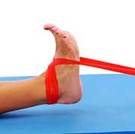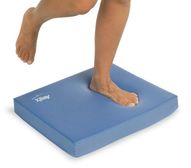|
Ankle sprains are one of the most common injuries in cheerleading, and sports in general. There are several things that athletes can do to help prevent ankle sprains from occurring. Here are my Top 5:  1. Build Up Ankle Strength. Having strong muscles that support your ankle will act as a “brace” to support the ankle and aid in preventing ankle sprains from occurring. A physical therapist can prescribe specific individualized exercises, some of which may include: lunges, single leg squats, resistance band exercises, or toe/heel raises.  2. Improve Your Balance. Improving your balance is another great way to prevent ankle sprains. To understand how good balance will help, it is important to understand how the body’s balance system works. There are 3 main components to how the body balances itself. The first is through vision. When you see your surroundings, you are able to anticipate the environment and react accordingly. The second is with the vestibular system, or the inner ear, telling you that your body is moving, spinning, or changing positions. Without the help of the eyes, your body relies on the senses to know where it is in space, this is called proprioception and is the third component. The nerves in your foot and ankle help you sense the surface of the ground when you are running, walking, jumping, etc. Ways to improve the proprioception of the ankle is to work on different balance activities, such as standing on one leg.  3. Strengthen Your Core. The strength of your hips and trunk are important in controlling how the parts below move and function, including the ankles. Imagine if you were running in one direction and changed abruptly. If you lacked strength in your core, your feet and ankles would likely continue going in the initial direction, potentially leading to an ankle sprain.  4. Increase Flexibility. It is important to keep a good balance between strength and flexibility. Having adequate mobility in the ankle will allow the ankle to have a little more “give” before an injury occurs. However, hypermobility (increased mobility) of the ankle is one of the leading risk factors of ankle sprains, so too much flexibility can be a bad thing. A physical therapist can help you determine if you have too much, too little, or just enough ankle flexibility. 5. Progressive Activity. If you have taken some time off, either between seasons, or during a holiday break in the middle of the season, it is a good idea to return back gradually. Getting your body back into the habit of the activities performed in the sport can help decrease the risk of ankle injury.
1 Comment
Thanks for sharing the article, and more importantly, your personal experience of mindfully using our emotions as data about our inner state and knowing when it’s better to de-escalate by taking a time out are great tools. Appreciate you reading and sharing your story since I can certainly relate and I think others can to
Reply
Leave a Reply. |
Archives
April 2022
Categories
All
Disclaimer: The information contained on this website is compiled from a variety of professional sources as well as the author's own experiences. The information should NOT be used in place of a visit to your healthcare provider or used to disregard any advice provided by your healthcare provider.
|

 RSS Feed
RSS Feed